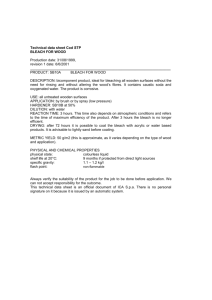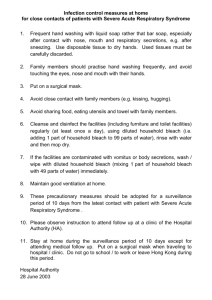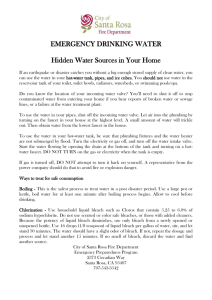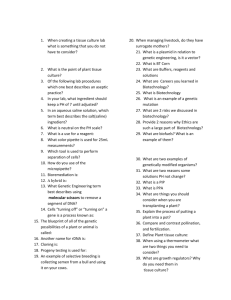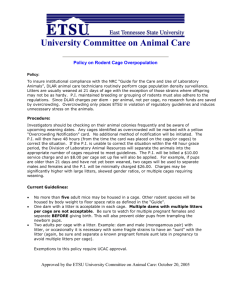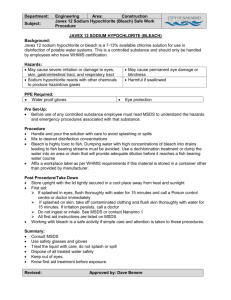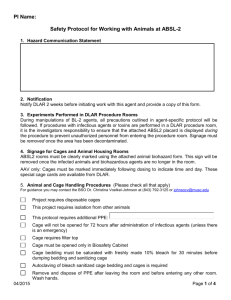Limiting Transmission of disease
advertisement
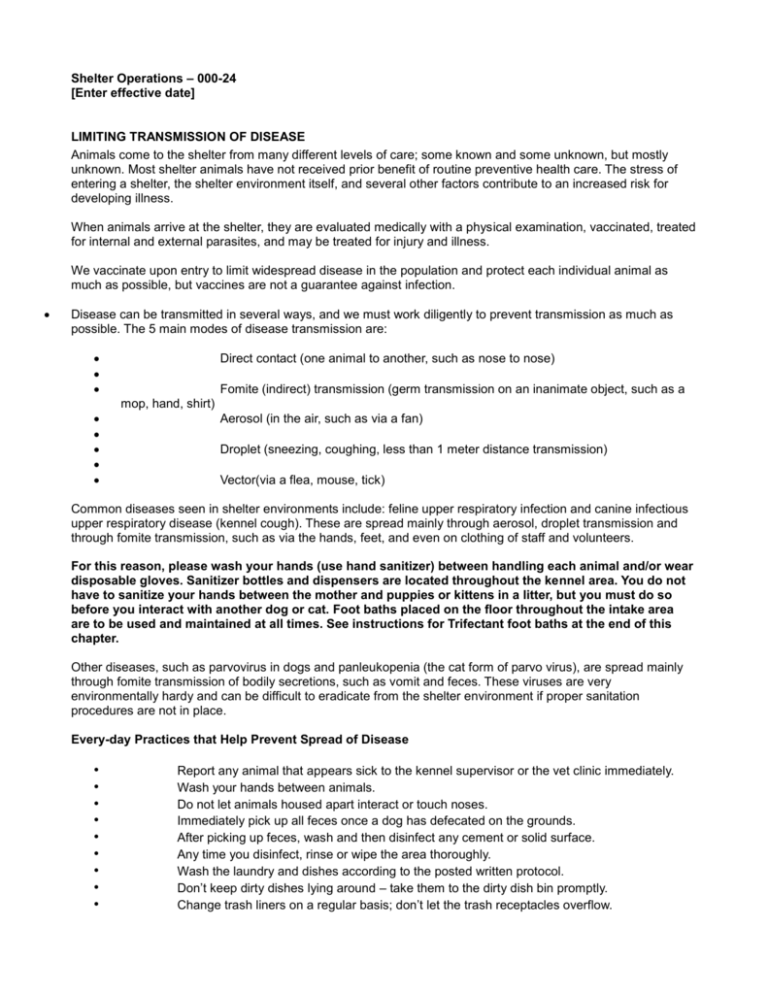
Shelter Operations – 000-24
[Enter effective date]
LIMITING TRANSMISSION OF DISEASE
Animals come to the shelter from many different levels of care; some known and some unknown, but mostly
unknown. Most shelter animals have not received prior benefit of routine preventive health care. The stress of
entering a shelter, the shelter environment itself, and several other factors contribute to an increased risk for
developing illness.
When animals arrive at the shelter, they are evaluated medically with a physical examination, vaccinated, treated
for internal and external parasites, and may be treated for injury and illness.
We vaccinate upon entry to limit widespread disease in the population and protect each individual animal as
much as possible, but vaccines are not a guarantee against infection.
Disease can be transmitted in several ways, and we must work diligently to prevent transmission as much as
possible. The 5 main modes of disease transmission are:
Direct contact (one animal to another, such as nose to nose)
Fomite (indirect) transmission (germ transmission on an inanimate object, such as a
mop, hand, shirt)
Aerosol (in the air, such as via a fan)
Droplet (sneezing, coughing, less than 1 meter distance transmission)
Vector(via a flea, mouse, tick)
Common diseases seen in shelter environments include: feline upper respiratory infection and canine infectious
upper respiratory disease (kennel cough). These are spread mainly through aerosol, droplet transmission and
through fomite transmission, such as via the hands, feet, and even on clothing of staff and volunteers.
For this reason, please wash your hands (use hand sanitizer) between handling each animal and/or wear
disposable gloves. Sanitizer bottles and dispensers are located throughout the kennel area. You do not
have to sanitize your hands between the mother and puppies or kittens in a litter, but you must do so
before you interact with another dog or cat. Foot baths placed on the floor throughout the intake area
are to be used and maintained at all times. See instructions for Trifectant foot baths at the end of this
chapter.
Other diseases, such as parvovirus in dogs and panleukopenia (the cat form of parvo virus), are spread mainly
through fomite transmission of bodily secretions, such as vomit and feces. These viruses are very
environmentally hardy and can be difficult to eradicate from the shelter environment if proper sanitation
procedures are not in place.
Every-day Practices that Help Prevent Spread of Disease
•
•
•
•
•
•
•
•
•
Report any animal that appears sick to the kennel supervisor or the vet clinic immediately.
Wash your hands between animals.
Do not let animals housed apart interact or touch noses.
Immediately pick up all feces once a dog has defecated on the grounds.
After picking up feces, wash and then disinfect any cement or solid surface.
Any time you disinfect, rinse or wipe the area thoroughly.
Wash the laundry and dishes according to the posted written protocol.
Don’t keep dirty dishes lying around – take them to the dirty dish bin promptly.
Change trash liners on a regular basis; don’t let the trash receptacles overflow.
•
Sanitize equipment such as coaxing sticks between cats; disinfect control poles and pooper
scoopers between uses.
If we all follow the same procedures the risk of having a disease problem will be greatly
minimized.
Trifectant Foot Bath Protocol
The correct mixture of trifectant to be used for foot baths: for every ½ gallon of water add 4 trifectant tablets to
the water (it is very important that you wear rubber gloves when handling the tablets)
Wait until tablets are completely dissolved
For each foot bath you will need:
a large clean litter pan
a clean towel folded so that it fits the entire bottom of the litter pan
add a ½ gallon of the trifectant/water mixture to each foot bath
The trifeactant remains stable for 7 days, foot baths will need changed once a week.
PRECAUTIONARY STATEMENTS
HAZARDS TO HUMANS AND DOMESTIC ANIMALS
DANGER. Powder is Corrosive. Causes irreversible eye damage and skin burns. Harmful if swallowed or
absorbed through the skin. Do not get in eyes, on skin or on clothing. Wear goggles (or face shield). Wear
protective clothing (long sleeve shirt and long pants, socks plus shoes and chemical resistant gloves such as
water proof gloves). Wash hands before eating, drinking, chewing gum, using tobacco or using the toilet.
Remove contaminated clothing and wash clothing before reuse.
General Cleaning Solution Ratios
Bleach 1/2c/gallon of water
DMQ 2 oz/gallon of water
Window Cleaning Solution ¼ cup vinegar,1/2tsp dish soap, 2cups water-shake well
Shelter Operations- 000-25
[Enter effective date]
Cleaning Areas Housing Animals – General Instructions
Begin morning cleaning by:
1) Feeding the Puppies and Dogs
2) Setting up kitchen for dishes
3) Removing all food and water dishes from adult cats
To cut down on cross contamination clean areas where animals are housed in the following order and disinfect
cleaning tools between each area.
ADOPTION SIDE
Cats:
Cat Rooms
Display Cats
INTAKE SIDE
Cats:
Nursery
Admission
Transition
ISO
Dogs:
Outside Kennels
Inside Kennels
Display Dogs/Cats
Dogs:
Nursery
Outside Kennels
Inside Kennels
ISO
Please be fair to your co-workers! If you are cleaning the cat areas, you are responsible for cleaning the litter
pans, dishes, toys etc. If you are cleaning the inside dog runs, you are responsible for cleaning the outside runs!
Initial the cleaning check chart immediately after completing a task.
Make sure all tools are properly cleaned/disinfected and stored in the proper place at the end of your shift. Do
not leave scrapers, brooms or other cleaning supplies in the sink!
Check Dog, Cat food and litter bins before end of your shift. If needed, refill .
Please remember to inspect , remove all solid matter and clean all strainers in the floor drains to prevent
blockages.
Make sure there are several litter pans pre-set in the feed room so they are ready for admissions if
needed.
Shelter Operations 000-26
[Enter effective date]
WORKING IN THE ANIMALFOOD PREP AREA
GENERAL : All animal food prep and dish washing is to be done in the intake kitchen, NOT in the Community
Room kitchen. This is an Ag & Market regulation.
WASHING THE DISHES
•
•
•
•
Fill the first sink with warm water and detergent.
Fill the second sink with cold water and 1 cup of bleach:
Fill the third sink with plain warm water for rinsing
When finished with the dishes, drain and clean debris from all the tubs.
Disinfecting Dishes:
•
Clean any food particles from the dishes by wiping them out into the trash. Do not allow solid matter to enter
the sink.
•
Place dishes in the detergent solution and scrub completely with a green scrubbie (no sponges) inside and
place the bowl in a clear water rinse:
•
Place dishes in the bleach solution and leave for a minimum of 10 minutes.
•
Place dishes in the rinse water and thoroughly rinsed under running water until there is no bleach residue.
•
Stack dishes upside down so they can drain on the racks next to the dish area.
•
When dishes are dry, take them back to the proper area: clean dish area for dogs and cats or the food prep
area. Do this by the end of the day so there are clean dishes for the next day.
Shelter Operations- 000-27
Enter effective date]
ANIMAL FEEDING
The Potsdam Humane Society participates in the Hill's Science Diet Feeding Program. Ordering food is the
responsibility of the Vet Techs.
Puppies and Dogs
Morning Feeding
Start with Adoption wing, move to the other animal areas, and end with the animals in Isolation areas.
IF THERE IS A “DO NOT FEED” SIGN ON AN ANIMAL’S CAGE, DO NOT FEED THAT ANIMAL!! ANIMALS
THAT ARE FED BEFORE SURGERY CANNOT BE SPAYED OR NEUTERED.
Amounts per serving are as follows and are for the general population. Specific feeding instructions for animals
with special diets will be noted on their kennel tags: Puppies 6 months and younger are fed at 6am and again at
3pm along with any animal who needs to gain weight.
X-Large dogs (90 lbs and over) = 5 cups of adult dog food
Large dogs (60 - 90 lbs) = 4 cups (not heaping) adult dog food
Medium dogs (35 - 50 lbs) = 2 cups of adult dog food
Small dogs (5 - 30 lbs) = ½ to 1 cup of adult dog food
Puppies = ½ cup of each pf puppy food. Check for specific notes as some pups may require a mixture of canned
food or dry kibble mixed with water to create a slurry.
Staff assigned to clean puppies are responsible for feeding the puppies and the nursing mothers. Use puppy
chow and wet food as indicated in daily notes. If there is a mother nursing she gets puppy chow also. Puppies
must be fed in a large flat bowl that allows all the puppies to eat easily. If necessary, use several bowls or the
feeding troth.
The food dishes are collected during clean up and taken to the animal food prep area for cleaning and
disinfection.
Kittens & Cats
Start with Adoption wing, move to the other animal areas, and end with the animals in Isolation .
Feed felines as outlined in cat cleaning protocols.
Amounts per serving are as follows:
Adult Cats (15 lbs and over) 3/4 cup
Adult Cats (5-10 lbs) 1/2/ cup
Pregnant & Nursing cats 1 cup
Kittens ( 4-6 months old) ½ cup
Kittens ( less than 4months) ¼ cup
Exotic Pets & Animals with Special Needs: The Vet Techs will provide instructions for animals with special
dietary needs. Staff are responsible for checking the assessment desk for daily updates .
Shelter Operations- 000-28
[Enter effective date]
DAILY ANIMAL HOUSING CLEANING
Adoption Cat Rooms
Clean One Room at a time.
Put all blankets from the adoption cats in the adoption dirty laundry bin.
Empty and scrape out the litter pans, take these and all toys and dishes to the kitchen for cleaning.
Sweep floor completely.
Clean glass with Windex or Vinegar and water solution.
Wipe down walls from ceiling to floor and any non-porous items with the bleach solution.{ ½ cup bleach to 1
gallon water}
Wipe down vents in ceilings.
Mop floor
Re-set with blankets, litter, food/ water dishes and toys.
Place at least 3 litter pans per room well away from food and water dishes.
Outside Cat Runs:
Sweep daily and scrub with bleach and water solution. Weather permitting.
ADOPTION DOG RUNS
Feed Dogs first thing in the morning when you get in.
Do outside runs first.
Outside:
Scrape up and remove all feces.
Spray walls, floor and chain link with soap hose, let set 10 minutes, scrub, rinse, sweep out any excess water
and towel dry.
Make sure there are no clumps of feces, hair or food left in the outside gutter areas. Check outside drain areas
for blockages.
Inside:
Take food dishes, toys, water dishes and blankets to kitchen or laundry for cleaning. This includes all water
buckets DAILY!
Scrape and remove all feces.
Sweep out all excess hair and food. Make sure there is nothing to clog the drains!
Spray runs with soap hose and let soak 10 minutes, scrub walls. Floors and cage doors. Rinse.
Spray and wash Kuranda beds, let soak 10 minutes, rinse and let dry.
Squeegee or sweep out runs. Dry with towel. DO NOT LEAVE PUDDLES!
Wipe down kennel windows, leaving no streaks!
Reset kennel runs with fresh water. Use blankets and beds.
In mild weather,dogs will be left outside until we open.
Sweep, spray with soap hose, let set 10 min. scrub, rinse and dry.
Tie off all bags of debris and feces {Including those in Play Area} and take to the dumpster.
Soak all brooms, squeegees, scrapers, dust pans etc. in bleach solution for 10 minutes and rinse. Place
sanitized tools back in
Appropriate storage areas.
SMALL ANIMAL DISPLAY
Remove animal and place in clean carrier.
Remove food/water dishes, take to kitchen to be cleaned.
Empty and scrape any litter into garbage and take dirty pan to kitchen.
Take any bedding to laundry.
If there are newspapers and shredding in display, put in garbage.
With properly mixed bleach/water solution and clean cloth completely wash walls window and bottom and top of
area.
Let set 10 min. and dry with clean towel.
With Windex or Vinegar solution spray window inside and out leaving no streaks!
Replace with clean bedding/ paper.
Put in clean litter pan if needed.
Put in clean Water/Food dish and toy with appropriate animal.
Place animal back in proper area they came out of.
Tie up garbage and take to dumpster.
If a carrier has been used spray carrier completely inside and out with a bleach spray bottle {1oz. Bleach
to 32 oz. Water} let set 10 minutes and rinse with clean water and dry with towel.
OFFICE/RECEPTION AREA
The receptionist on duty is responsible for daily cleaning, sweeping and mopping reception desk and ED
Office. Cleaning staff will be responsible for the public sections of the reception area and the hall
leading to the adoption wing.
If there are animals in cages they are cleaned according to the type of cage they are in.
Empty any garbage if any.
With Windex or Vinegar solution clean all windows and doors. Leaving no streaks!
With properly mixed bleach/water mixture {½ cup bleach to 1 gallon water} and clean cloth wipe down furniture,
and window casings.
Wipe down vents and heaters with cloth and bleach mixture.
Sweep or vacuum rugs or shake out.
Sweep floors.
Mop floors.
NURSERY
Fill buckets with a bleach solution {½ cup bleach to 1 gallon of water} Dump out when done!
Kittens:
Empty food dishes and scrape out litter pans in the trash
Take dishes, litter pans to the kitchen for cleaning
Take blankets to laundry
Sweep debris from cages.
Sweep the floor.
Tie off all trash bags and take to the dumpster.
Wipe down all cage surfaces{ With Kittens still in cage} using a wash cloth and bucket with a bleach solution of
½ cup bleach to 1 gallon of water.
Use a new cloth for each cage.
Use a dry hand towel to dry all surfaces of the cage. { Use a new towel for each cage.}
Mop the floor with the bleach water solution. Make sure you get under and behind the cages.
Clean the strainer in the floor drains.
Wipe down the heater, vents and any other fixtures including the inside and outside of the door with the bleach
solution. Clean the glass with Windex or Vinegar solution.
Set cages back up: Put a clean blanket in bottom, clean litter pan, fresh food and water and a toy in each cage.
If you cannot clean with the animal in the cage you need to speak to Vet Tech before placing animal in
carrier.
If tech is not in yet move on and come back to that area.
If a carrier has to be used spray carrier completely inside and out with a bleach spray bottle {1oz. Bleach
to 32 oz. Water} let set 10 minutes and rinse with clean water and dry with towel.
Puppies:
Place puppies in carriers, keeping litters together. Never mix litters.
Roll up newspaper and place in trash.
Sweep all remaining debris from the runs.
Place debris in trash with rolled newspaper from runs. Tie bag off and take it to the dumpster.
Use the soap hose and spray all the walls and floors. Don’t forget the inside of the glass door. Scrub all walls
and floor. Let soak for 10 minutes.
Rinse with plain water from the hose, squeegee the floor, and dry with towels.
Re-set with 8-10 layers of flat newspaper and a generous amount of shredded paper, a blanket, toys, and food
and water dishes.
Move pups back into runs.
Scoop feces and sweep up shredded paper from outside run. Making sure to get all shredded paper from around
Chain link fencing! Repeat steps 4-6.
If a carrier has been used spray carrier completely inside and out with a bleach spray bottle {1oz. Bleach
to 32 oz. Water} let set 10 minutes and rinse with clean water and dry with towel.
In event drains are not working:
Fill 5 gallon pail ½ full of water to ½ cup bleach ratio.
Scrub all surfaces with the brush and wipe down with clean towels.
Completely dry floors!
Feline Admissions & Transition
Check the MYM clipboard and perform cage assessments on all newly admitted cats.
Take all food/water dishes to the kitchen for cleaning.
Take blankets to laundry
Remove litter pans and scrape used litter into the trash. Take litter pans to the kitchen for cleaning.
Remove debris from cage surface { with cat still in the cage}
Using a different cloth for each cage, wipe down all cage surfaces { with cat still in the cage}
Using a wash cloth and a bucket with a bleach solution of ½ cup bleach to 1 gallon of water.
Dry each cage with clean cloth for each cage.
Sweep floor, moving cages to get in behind and under.
Tie off all trash bags and take to the dumpster.
Mop the floor with the bleach solution. Make sure to get behind and under all cages.
Clean the strainer in the floor drain.
Wipe down the sink, and any fixtures including inside and outside of door. Clean window with Windex or Vinegar
solution.
Clean ceiling vent.
Set cages back up: Put clean blanket in each cage, litter box, food/water dish and a toy in each cage.
If you cannot clean with the animal in the cage you need to speak to Vet Tech before placing animal in
carrier.
If tech is not in yet move on and come back to that area. Only do this with Feral, frightened or fractured
cats!
If a carrier has to be used spray carrier completely inside and out with a bleach spray bottle {1oz. Bleach
to 32 oz. Water} let set 10 minutes and rinse with clean water and dry with towel.
INTAKE DOG RUNS
Feed Dogs first thing in the morning when you get in
Do outside runs first.
Outside:
Scrape up and remove all feces.
Spray walls, floor and chain link with soap hose, let set 10 minutes, scrub, rinse, sweep out any excess water
and towel dry.
Make sure there are no clumps of feces, hair or food left in the outside gutter areas. Check outside drain areas
for blockages.
Inside:
Take food dishes, toys, water dishes and blankets to kitchen or laundry for cleaning. This includes all water
buckets DAILY!
Scrape and remove all feces.
Sweep out all excess hair and food. Make sure there is nothing to clog the drains!
Spray runs with soap hose and let soak 10 minutes, scrub walls. Floors and cage doors. Rinse.
Spray and wash Kuranda beds, let soak 10 minutes, rinse and let dry.
Squeegee or sweep out runs. Dry with towel. DO NOT LEAVE PUDDLES!
Wipe down kennel windows, leaving no streaks!
Reset kennel runs with fresh water. Use blankets and beds.
Dogs will be left outside until we open. “ Weather permitting”
Sweep, spray with soap hose, let set 10 min. scrub, rinse and dry.
Tie off all bags of debris and feces. {Including those in Play Area} and take to the dumpster.
Soak all brooms, squeegees, scrapers, dust pans etc. in bleach solution for 10 minutes and rinse. Place
sanitized tools back in the storage area opposite the employee restroom.
TRANSITION CAGES/HALLWAY
With Cat still in cage.
Place divider in between cages.
Remove food/water dish.
Remove litter pan, scrape out into garbage.
Remove any bedding in cage.
Take dirty dishes and litter pans to kitchen.
Take dirty laundry to wash.
With a bucket of bleach/water solution{½ cup bleach to 1 gallon water} and clean cloth wash down empty cage
area.
Be sure to get in and around all the corners, sides, top and bottoms of cage.
Let set for 10 minutes and completely dry with clean towel.
Move Cat to other side and repeat.
Place clean litter pan, food/water dish, toy and blanket.
Take divider out making sure the divider is also properly cleaned.
Pull cages out from wall and wash walls and ceiling area down around cages with a bucket of bleach/water
solution.
Completely sweep transition area including the hallway starting at door from kitchen to intake kennel door.
Remove cob webs, dust, dirt from walls and ceiling.
Mop all area and let dry.
CAT ISOLATION
You must wear a gown and booties at all times in this room.
This Room is to be Cleaned Last!
Transfer cats from the cage to the pet carrier labeled with the same red cage number.
Place all food/water dishes{ Once they have been emptied}, blankets and toys in a clear garbage bag. Tie off
and set outside door.
Remove all newspaper and debris from the cages and place in trash.
Sweep out cages and sweep the floor. Check and clean the strainers in the floor, clean out debris.
Pull all cages out away from the walls.
Wash down walls with properly ratio mixed Bleach/Water solution.
Remove filter from heater/air-conditioning unit and wipe down with clean bleach/water cloth.
Spray with properly ratio mixed Bleach/Water solution. Spray inside, outside, tops, in between and doors of
cages. Let set for 10 minutes. Scrub door and all of interior and exterior of each cage with a new cleaning cloth. “
Make sure to get between the cages all the way”
Dry the inside and outside areas with a new clean cloth. “Make sure they are completely dry inside and outside!!”
Set cages back up: Cover cage bottoms with blanket, clean litter pan and clean food/water dish refilled. Place
cat back in properly marked cage according to cage tag on carrier.
Completely spray the pet carriers inside and outside with properly
Mixed Bleach/Water solution. Let set 10 min. Wipe out with dry cloth, making sure they are dry and cover with a
clean sheet or blanket daily!
Make sure any un-used cages are clean,dry, and completely empty.
Mop with properly ratio mixed Bleach/Water solution.
Tie up bagged feces and garbage, removing booties, and gown.
Put gown in laundry every day! Do not hang or leave gown !
Bring garbage immediately to dumpster. Bring bagged dishes, litter pans in closed bag to sink area and
wash accordingly.
DOG ISO
Check with Vet Techs daily regarding animals in this area and how it should be cleaned.
It there are no animals in the dog ISO room on Medical Quarantine
Follow general cleaning protocols for type of animal and type of cage they are in.
When cleaning with ISO protocols in place follow the following instructions.
Have all cleaning equipment, food/water dishes, litter pans, blankets etc. all ready at the door to enter.
Put booties, gown and gloves on and enter the area.
Work on one cage at a time, changing gloves after each cage is done, to further transfer any infectious disease
that may be present.
Dogs: Remove dog from cage and place in clean crate, marked for that animal.
Never place animals in same crate before completely disinfecting.
Remove paper and shredding if in cage and place in garbage bag.
Remove any bedding and toys and put in garbage bag.
Remove Food/Water dish, place in separate bag.
Tie up bags to be taken out later.
Sweep area of any debris and place in garbage container.
With a bucket of bleach water solution {½ cup bleach to 1 gallon water} wash down all kennel walls, including the
metal rails on top of cages and doors inside and out.
Scrub with brush and let soak for 10 min.
Dry with clean towel. Never using same towel or cloth for more than one cage at a time.
Mop floor with bleach water solution properly diluted.
Dry with towel.
Place 8-10 layers flat paper down in back of cage.
Place a blanket in front and bed when needed.
Put in fresh clean water dish, food and toy.
Put animal back in kennel.
With new crate and new gloves and cleaning cloths repeat until all kennels are done.
Make sure also that you have cleaned windows with Windex or Vinegar solution properly mixed.
Cat cages ( for cats housed in the dog ISO room): If cat is sick and on quarantine follow proper Cat ISO
protocols as listed on Cat ISO cleaning protocol sheet.
If cat is not sick clean and treat as you would an Admission cat.
Once Dog and Cat areas are done:
Sweep the entire floor, getting in corners and under and behind everything.
Clean out vents on Heater/AC Unit with Damp cloth with Bleach/Water solution.
Clean ceiling vent.
Wash down inside and outside of entrance door, and window with Vinegar solution.
Completely spray the pet carriers inside and outside with properly
Mixed Bleach/Water solution. Let set 10 min. Wipe out with dry cloth, making sure they are dry and cover with a
clean sheet or blanket daily!
When leaving Dog ISO area:
Take off booties and gloves and place in garbage. Tie garbage up and set outside door.
Remove gown and place in dirty laundry bag.
Take bags of laundry and dishes and set outside door.
Do not leave any newspaper or supplies inside the area.
Take bags of laundry, dishes and garbage to proper areas.
Dump mop water and change mop head and place in laundry before moving on to new area.
Shelter Operations- 000-29
[Enter effective date]
Cleaning Areas Not Housing Animals
ASSESSMENT ROOM ( Daily)
Sweep area daily, mop with proper cleaning mixture of bleach/water.
If there are any cages with animals in them use proper cleaning protocols according to type of cage and animal.
Wash all windows and doors weekly with proper cleaning
Solutions.
BATHROOMS ( Daily)
Empty garbage and replace with clean bag.
With a bucket of properly mixed bleach/water solution and cloth, wipe down all walls. Clean of ceiling vent.
.
With properly mixed bleach/water solution wash toilet inside and out.
Clean inside of toilet with mixture and scrub brush or cloth
With clean cloth wipe down cabinets.
With properly mixed bleach/water solution clean sink and
Facets.
With properly mixed vinegar solution or Windex, clean mirror and stainless steel garbage/towel dispenser.
Refill towel dispenser.
Refill toilet paper.
Sweep and mop floor.
FEED ROOM (Daily)
All Cat food, Dog food or other animal food needs to be kept on shelving units or on pallets off the floor.
Cleaning supplies will not be kept near any food.
All food bins/ pellet bins will be marked accordingly.
Covers will be left on all containers at all times.
No food left open in bags.
Floor area should be swept of any debris and mopped daily with proper bleach/water solution.
All vents and heating units need to be washed off daily.
BOILER ROOM(Daily)
Area near furnace and any electrical equipment will be kept free of any debris.
Area should be swept and mopped daily.
Keep any cleaning equipment properly hung up or put in safe place.
Any food or treats will be kept in closed container away from furnace/electrical area.
Any dog collars/leashes will be hung on hooks available on wall.
Any air vents will be cleaned daily
Furnace filters will be checked and changed if needed the 1st of every month.
No garbage or recyclables will be left in the boiler room.
Bag up all garbage/recyclables and take to dumpster.
LAUNDRY ROOM(Daily)
Do Not overload Washers and Dryers!!!
All wash is set on Cold/Cold! Washer set to Large Load!
Remove all feces, paper and litter from blankets and towels before placing them in the laundry bin.
For each load of laundry:
Add ¼ cup bleach and ¾ of a cup of laundry soap. Close lid and let fill with a small amount of water.
Add laundry. Suggested load sizes: 6-8 towels per load or 4 light weight blankets per load,or 10=15 small cat
blankets per load. Cloth toys are to be washed with laundry.
Remove lint from dryer lint trap between each load. Shake out each item and place in dryer. Do Not Overload!
Neatly fold all laundry and place on appropriate shelving units.
Clean the interior of the washers, wipe down the exterior of washers and dryers. Do Not forget to clean the COIN
SLOTS!
Sweep Floor daily
Do not pour bleach and soap directly on laundry!
KITCHEN :End of cleaning shift everyday
Make sure all dishes, litter pans, tools and equipment are properly washed, dried and put away in areas marked.
Put wet and dirty towels and cleaning clothes in laundry
Wash off counter tops and sterilize with proper bleach/ water solution.
Clean sinks out and do not leave any dirt, food, litter remains.
Straighten shelves with canned food, dish area, etc.
Do not leave any soda cans, coffee cups or silverware out.
Sweep floor
Tie off garbage and take out to dumpster
Put new garbage bags in containers.
Take out any recyclables.
Mop floor
MULTI-PURPOSE ROOM (Daily)
Empty all garbage cans, and take to dumpster.
Replace with new bag.
Sweep floor, this includes hallway near Cat adoption areas down to door entering to ramp.
Wipe down counter tops and cabinets.
Wash any dishes you have used, and put away.
Put coffee supplies in cabinet.
Mop floor.
EQUIPMENT ROOM (Daily)
Sweep Equipment room.
Remove dust and cob-webs.
Place all cleaning equipment back in a neat and orderly fashion.
Mop once a week on Sundays.
PREP ROOM/SURGERY ROOM
These 2 rooms are to be cleaned, prior to and immediately after surgery, by Vet. Techs.
Prep Room area: Wash with proper bleach/water solution
½ cup bleach to 1 gallon water} and clean cloth wash down all furniture, cabinets, equipment, tables.
Remove dust and dirt from ceiling vent.
Table surfaces should be disinfected after any new animal has been on table areas. Esp. when doing new
physicals on
Animals.
Floor needs to be mopped in between new animals entering
This area. {Excluding Surgery days.}
Sweep floor daily and mop.
Remove trash and take to dumpster.
Surgery Room:
Weekly or day prior to surgery: Disinfect all surfaces, cabinets and equipment, light fixtures.
Wipe down heater/ AC unit. Removing filters and washing with properly mixed bleach/water solution.
Sweep and mop.
When surgery is finished remove any garbage to outside dumpster.
Monthly Cleaning Duties:
These duties are done either by Shelter cleaning staff, Work Study
Students or Volunteers.
All furniture and cabinets in the Multi-purpose room are washed down and cleaned inside, out and tops.
All windows are washed inside and out. “ Weather permitting”
All air vents in general shelter areas are cleaned and washed out.
Areas where there are animals are done on a daily basis.
Furnace and Air conditioning equipment are check and cleaned.
Filters in these areas are changed or cleaned monthly.
All lighting is washed down and debris removed.
Outside lighting, corners of buildings, and siding is checked for dirt and cob-webs.
Shower Room: This room is be kept free of clutter at all times and cleaned as follows after every use:
Clear all solid matter and hair from drain area using bleach mix ( 1oz/32oz water) spray down shower stall from
top to bottom including fixtures, hand rail and seat. Let stand for 10 min.
Rinse all surfaces with clear cold water
Dry all surfaces
Sweep and mop floor
